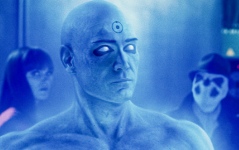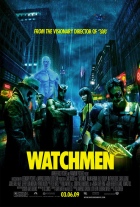Watchmen
|  A film adaptation of Alan Moore and Dave Gibbons’ acclaimed 1986 graphic novel Watchmen has been a long time coming, having been in development at various studios for some two decades and having attracted and ultimately expelled the likes of such directors as Terry Gilliam and Paul Greengrass. An epic, 400-page deconstruction of superheroics that mixes Nietzschean philosophy, psychological dysfunction, costume kitsch, and nuclear-age political satire, Watchmen has long been on the list of “unfilmable” books, mostly because of its dense, novelistic structure and dark view of humankind’s propensity for destroying itself. A film adaptation of Alan Moore and Dave Gibbons’ acclaimed 1986 graphic novel Watchmen has been a long time coming, having been in development at various studios for some two decades and having attracted and ultimately expelled the likes of such directors as Terry Gilliam and Paul Greengrass. An epic, 400-page deconstruction of superheroics that mixes Nietzschean philosophy, psychological dysfunction, costume kitsch, and nuclear-age political satire, Watchmen has long been on the list of “unfilmable” books, mostly because of its dense, novelistic structure and dark view of humankind’s propensity for destroying itself.It is thus not surprising, given the obvious need to make such a massive, complex project as commercial as possible, that it ultimately wound up in the hands of Zack Snyder, a filmmaker whose two previous efforts, the 2004 remake of Dawn of the Dead and the bloody graphic novel adaptation 300 (2007), have established him as a screen sensationalist (not “visionary,” as the studio is touting) better known for kinetic visual flourishes than thematic depth. To Snyder’s credit, he manages to maintain much of the book’s heady philosophical weight, albeit primarily by changing as little as possible from the source material (the ending is given a significant facelift, but maintains the essence). The book’s dense, multimedia narrative structure had to be simplified and streamlined for the screen by writers David Hayter and Alex Tse, who nevertheless maintain a strict fidelity that is also reflected in Snyder’s visualizations, many of which are drawn directly from the illustrated panels (interestingly, Snyder is at his best when he riffs on the source material, particularly a clever opening credits sequence that lays out the backstory in frozen images to Bob Dylan’s “The Times They Are A-Changing”). Snyder and cinematographer Larry Fong (with whom he worked on 300) have given Watchmen a gritty visual palette that is evocative of the brightly colored graphic novel, only darker and dingier. It is somehow both realistic and highly cartoonish, partially because the locations are so radically varied: everything from abandoned sewer tunnels, to a massive fortress in Antarctica (a play on Superman’s Fortress of Solitude?), to a prison in the midst of a riot, to the lonely valleys of the planet Mars. The film’s digital effects are plentiful, and almost uniformly effective in palpably rendering the story’s alternate universe, which is recognizable in the same way that we recognize places in our dreams: right, but not quite. Snyder, however, has a hard time leaving well enough alone, and he can’t help giving in to his desire to amplify everything, which frequently backfires. Most obvious are his needless slow-motion flourishes, which do less to intensify the various action sequences (which are given more prominence than in the graphic novel) than to draw undue attention to the film’s style. He also loads the soundtrack with recognizable songs that are both time-specific (“99 Luftballoons”) and theme-specific (“All Along the Watchtower”), and when they work they’re funny and witty, but when they don’t they’re annoying. With all the digital, cartoonish blood spurting in 300, it should come as little surprise that Watchmen is also graphically violent. Sometimes this amplified violence is forced, such as when a prisoner’s arms are cut off with a saw, but at other times it serves the material with character-defining intensity that works, such as the manner in which one hero uses a meat cleaver on a particularly twisted villain. The story takes place in an alternate 1985 in which Richard Nixon is still president and the United States is in an even more intense nuclear standoff with the Soviet Union. Costumed vigilantes, who were once a significant crime-fighting force and even formed their own groups, have been officially outlawed, which means that most of them are now in quiet retirement. Of course, because one of the goals of Watchmen is to deconstruct comfortable superheroisms, the “costumed adventurers” are a mix of decency and dysfunction, with some of them putting on their masks out of a genuine desire to stop crime, while others are ego maniacs enjoying the power trips, and still others are pushed into it against their will. In short, the heroes in Watchmen are decidedly human and reflect in many ways the very things they’re fighting. The story opens with the brutal murder of Edward Blake (Jeffrey Dean Morgan), who was once known as The Comedian. This sets off an investigation by Rorschach (Jackie Earle Haley), one of the few heroes who has refused to put away his mask. He has a theory that there is a “mask killer” who is hunting the former costumed vigilantes, and he approaches each of his former comrades: Dan Dreiberg (Patrick Wilson), a nebbish who used to be Nite Owl; Adrian Veidt (Matthew Goode), a billionaire and so-called “smartest man in the world” who has benefitted mightily from turning his alter ego Ozymandias into a merchandising boom; and Laurie Jupiter (Malin Akerman), who has followed in the path of her mother (Carla Gugino) as Silk Spectre. All of these vigilantes, it should be mentioned, are not supernatural. Rather, like Batman, they are ordinary men and women who have trained themselves to be superheroic or, in the case of Nite Owl, developed technological gadgetry to aid his endeavors. The only former hero with true superpowers is Dr. Manhattan (Billy Crudup), who was once a physicist named Jon Osterman before he was trapped in something called an Intrinsic Field Center that disintegrated him, after which he was reconstructed with godlike abilities. Now a glowing blue hulk of a man who can see the future, manipulate matter, and instantly transport himself and others through the cosmos, Dr. Manhattan has been in the service of the government as a kind of one-man national security shield. The Soviets wouldn’t dare launch an attack against the U.S. when the Americans have a man who could obliterate their entire continent with a wave of his hand. Yet, because of his powers, Dr. Manhattan has been slowly but steadily drawing away from the humanity of which he was once a part, seeing life as an “overrated phenomenon” and losing interest in a planet that is constantly on the brink of self-annihilation. An obvious literalization of Nietzsche’s übermensch (“superman”), Dr. Manhattan is a compelling literary conceit whose dispassionate assessment of humanity forces us to confront our inherent fallibilities even as he eventually comes around to recognizing the miraculous nature of human existence. As a god figure, he is both frightening and sad, and Billy Crudup’s performance, though wrapped almost entirely in a digital body, is quite impressive, especially the manner in which he uses a soft voice to offset Dr. Manhattan’s intense physicality and his increasingly inhuman logic. Arguably more fascinating, though, is Rorschach, who was once an abused kid named Walter Kovacs and is now arguably a sociopath (think Travis Bickle as a masked superhero). Rorschach pursues his sense of justice with a single-minded intensity, and Jackie Earle Haley, the former Bad News Bear who was nominated for an Oscar two years ago for playing a pedophile in Little Children (2006), gives a searing performance that is simultaneously enthralling and disturbing. You can’t help but like Rorschach because he lacks compromise, and even if his tactics are often brutal, they come from a well of both resentment and righteousness. His constantly shifting mask, though directly evocative of the Rorschach ink blot tests, conveys a sense of swirling intensity, as if we are actually watching his thoughts shifting, congealing, and then breaking apart. Like the film as a whole, he fascinates primarily because he disturbs our preconceptions and forces us to rethink all those superhero stories we’ve taken for granted for decades. Although it works as a good (though not great) story, Watchmen is really more of a philosophical treatise, pushing us to wonder why human life should matter when it is so violent and self-destructive and question whether peace through fear is really peace at all. Copyright ©2009 James Kendrick Thoughts? E-mail James Kendrick All images copyright © Warner Bros. and Paramount Pictures |
Overall Rating: 

 (3)
(3)


